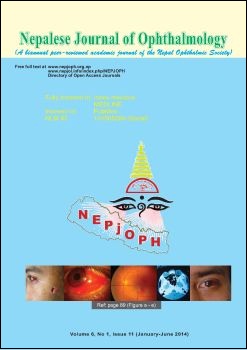Accuracy of intraocular lens power calculation in pediatric cataracts with less than a 20 mm axial length of the eye
DOI:
https://doi.org/10.3126/nepjoph.v6i1.10773Keywords:
pediatric cataract surgery, axial length, intraocular lens calculation formulae, prediction errorAbstract
Introduction: Selection of an appropriately-powered IOL is a complex issue, especially in eyes with an axial length of less than 20 mm in pediatric cataract.
Objective: To assess the accuracy of IOL power calculation formulae in pediatric cataracts in eyes with an axial length of less than 20 mm.
Materials and methods: The records of children less than 15 years old with congenital cataract who had undergone primary IOL implantation were analyzed.
Main outcome measures: The variables studied were axial length, keratometric values and the prediction error. The data were analyzed for prediction error determination using the SRK II, SRK T, Holladay 1 and Hoffer Q IOL power calculation formulae. The formula that gave the best prediction error was identified.
Results: Twenty-eight eyes of 19 children were included in the study. The absolute prediction error was found to be 1.84 ± 2.09 diopters (D) with SRK II, 2.93±3.55D with SRK T, 3.63±4.06D with Holladay 1, and 4.83±5.02D with Hoffer Q. The number of eyes with the absolute prediction error within 0.5 D was 6 (21.42%) with SRK II, 4 (14.28%) with SRK T, 1 (3.57%) with Holladay 1, and 3 (10.71%) with Hoffer Q. The absolute prediction error with SRK II formula was significantly better than that with other formulae (P < .001). The axial length influenced the absolute prediction error with Hoffer Q formula (P = 0.04). The mean keratometry influenced the prediction error with SRK T formula (P = 0.02), Holladay 1 formula (P = 0.02) and Hoffer Q formula (P = 0.02).
Conclusion: Although the absolute prediction error tends to remain high with all the present IOL power calculation formulae, SRK II was the most predictable formula in this study.
DOI: http://dx.doi.org/10.3126/nepjoph.v6i1.10773
Nepal J Ophthalmol 2014; 6 (2): 56-64
Downloads
Downloads
Published
How to Cite
Issue
Section
License
This license enables reusers to copy and distribute the material in any medium or format in unadapted form only, for noncommercial purposes only, and only so long as attribution is given to the creator.




